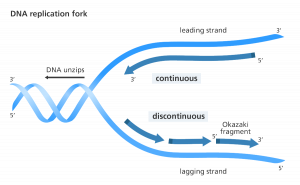
DNA replication, also known as semi-conservative replication, is the process by which DNA is duplicated. This is an important process that takes place within the dividing cell.
DNA structure
DNA is made up of millions of nucleotides. These are molecules made up of deoxyribose sugar, with phosphate and a base (or nucleobase) attached to it. These nucleotides are linked together in strands through phosphodiester bonds to form a “sugar-phosphate backbone”. The bond formed is between the third carbon atom of the deoxyribose sugar of one nucleotide (known as 3′) and the fifth carbon atom of another sugar in the next nucleotide (known as 5′).
There are two strands of DNA, running in opposite directions or antiparallel to each other. These strands are linked to each other along their entire length through the bases of each nucleotide. There are 4 different bases associated with DNA: cytosine, guanine, adenine, and thymine. In normal DNA strands, cytosine binds to guanine and adenine to thymine. When joined, the two strands form a double helix structure.
What is DNA replication?
DNA replication is the process by which DNA makes a copy of itself during cell division.
1. Is the first step in DNA replication to “unzip” the double helix structure of DNA molecules.
2. Is this carried out by an enzyme called helicase that breaks hydrogen bonds holding the complementary bases of DNA together (A with T, C with G).
3. The separation of the two single strands of DNA creates a ‘Y’ shape called a replication ‘fork’. The two separate strands will act as templates to make the new DNA strands.
4. One of the strands is oriented in the 3′ to 5′ direction (towards the replication fork), is this the main strand. The other strand is oriented in the 5′ to 3′ direction (away from the replication fork), is this the lagging strand. As a result of their different orientations, the two strands replicate differently:

Main filament:
- A short piece of RNA called a primer (produced by an enzyme called primase) arrives and attaches to the end of the main chain. The primer acts as a starting point for DNA synthesis.
- DNA polymerase joins the main strand and then “walks” along with it, adding new complementary nucleotide bases (A, C, G, and T) to the DNA strand in the 5′ to 3′ direction.
- This type of replication is called continuous.
Lagging strand:
- Numerous RNA primers are produced by the enzyme primrose and bind at various points along the lagging strand.
- Pieces of DNA, called Okazaki fragments, are then added to the lagging strand also in the 5′ to 3′ direction.
- This type of replication is called discontinuous since the Okazaki fragments will have to come together later.
5. Once all the bases are paired (A with T, C with G), an enzyme called exonuclease removes the primers. The gaps where the primers were are filled with even more complementary nucleotides.
6. The new strand is checked to make sure there are no errors in the new DNA sequence.
7. Finally, an enzyme called DNA ligase seals the DNA sequence into two continuous double strands.
8. The result of DNA replication is two DNA molecules consisting of one new and one old strand of nucleotides. This is why DNA replication is described as semi-conservative, half of the strand is part of the original DNA molecule, half is new.
9. After replication, the new DNA automatically coils into a double helix.
